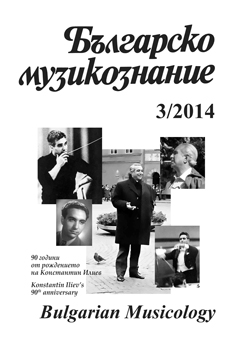Стилови и интерпретационни особености в камерните произведения на Васил Казанджиев за състав от струнна духови и пиано, композирани до 1997 година
Stylistic and interpretational specifics of Vassil Kazandjiev’s chamber works for winds, strings and piano, composed up to 1997
Author(s): Georgita Boiadjieva-NikolovaSubject(s): Music
Published by: Институт за изследване на изкуствата, Българска академия на науките
Keywords: Vassil Kazandjiev; chamber works for winds; strings and piano; music language; interpretational issues.
Summary/Abstract: This article is devoted to the 80th anniversary of Academician Vassil Kazandjiev (b. 5 September 1934), a notable Bulgarian composer, conductor and pedagogue. Vassil Kazandjiev is the author of numerous chamber works for unusual ensembles of various, differing in sounding instruments. Among these, there are five pieces for winds, strings and piano: Strofi [Verses] for flute/piccolo, violin and piano (1968), Concert Improvisations for flute, viola, harp and cembalo/piano (1974), Miraji [Mirages] for clarinet, violin, cello and piano (1997), Kaleidoscope (2002) and Trio-Sonata (2007) for clarinet, cello and piano. Chronologically, the pieces belong to different periods of his compositional work, while in terms of their expressive means such a division proves to be rather conditional. Kaleidoscope is solved entirely on the basis of sonorous and aleatoric means. It is closer to Strofi and Concert Improvisations (where the author used in various degrees the same compositional technique) than to Miraji, composed five years earlier, and Trio-Sonata, written five years later, where these means were applied especially and purposefully in some transitions and culminating points of the development. As the composer said, ‘I do not work by prescription, I do not devise in advance how this time the piece should look, but rather opt for my ideas intuitively, they would pop up in the act of expression and in my means of expression. The idea of a work of mine goes more often than not with a vision of a form, of an image and by image I mean the shape-generating process, the stages in the development’.
Journal: Българско музикознание
- Issue Year: 2014
- Issue No: 3
- Page Range: 17-36
- Page Count: 20
- Content File-PDF

